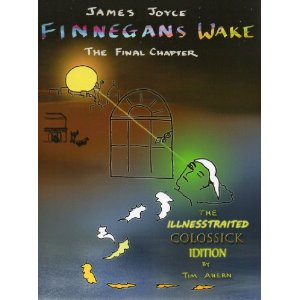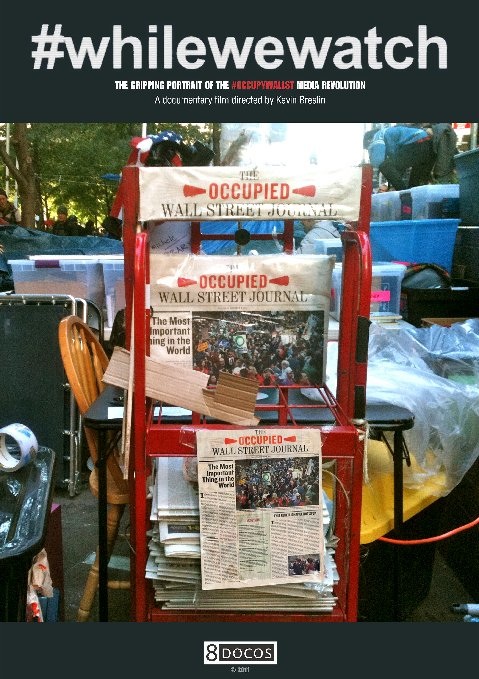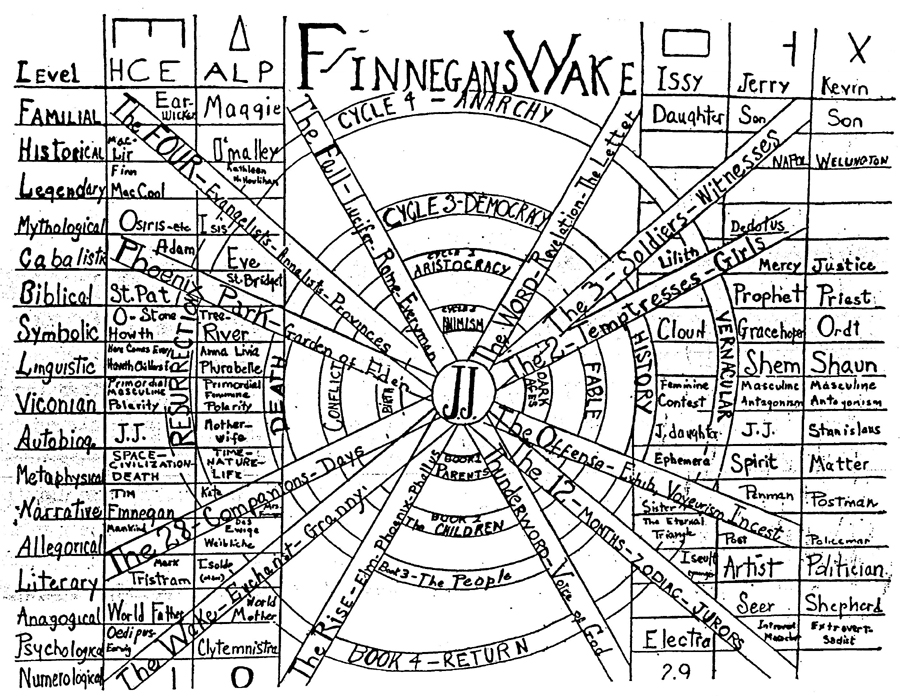Occupy Awake:
Conscious Mapmakers
On World Wide Watch
1 Mar 2012

"The map is not the territory" - Alfred Korzybski
Robert Anton Wilson popularized Korzybski's axiom to remind us that our inventions are interior transformations of consciousness. I recommend a new documentary and a new book by two mapmakers who search for new lands and new data. As the private goes public, how can we transcend and transform the global theater?
#WHILE WE WATCH, directed by Kevin Breslin, righteously chronicles the Occupy Wall Street Media Team in NYC's Zuccotti Park. His new 40 minute documentary delves into the tools of a social protest movement. From marches, tents and cardboard signs to the human microphone, gestures and live streaming video, the viewer swims in a whirlpool of sensory over-load. Yet Breslin navigates the route to reveal patterns of vibrant street activism and its ripplin' wake.
Breslin starts with Obama on TV and ends with Tom Morello doing Woody Guthrie on the street. In between, we experience a slew of others who flesh out a bigger picture as mainstream news reporting transforms into the birth of "citizen journalism." Rudy Giuliani, Major Bloomberg, Daily News editor Ian Bishop and NYPD press liaison Detective Paul J. Brown all speak up. "It's a PR dream," proclaims adman Ken Sunshine. Professor and indy filmmaker Karen Kramer talks about how it takes time to really get a good story, something mainstreamers rarely give thought to. Breslin offers an array of diverse viewpoints with many folks who articulate the changing landscape of media making and consuming: Flux Rostrum, Ice Creamer Ben Cohen, Occupiers Jesse, Justin, Pete and Democracy Now! producer Sam Alcoff, who speaks how corporate media cheerled economic practices that caused the 2008 crisis.
The placard with Abbie Hoffman's line: "The first duty of a revolutionist is to get away with it" is seen in Breslin's film. Abbie acknowledged McLuhan's influence. McLuhan acknowledged Joyce's influence by calling his 22 books "applied Joyce." Joyce acknowledged the influence of "Here Comes Everybody." Both McLuhan and Warhol said that art is anything you get away with. Transmedia and meta-narratives are leaking all over the curb. It's an interdepenDANCE of understanding relationships. Evolution is adapting to exploration. Revolution is adapting to...well...Phil Ochs sang "A demonstration should turn you on, not turn you off." Let's get it on.

In Finnegans Wake - The Final Chapter(The Illnesstraited Colossick Idition of Finnegans Wake) by Tim Aherns & James Joyce), artist Aherns adheres, I meme he "adds ears" to our eye-dominated reading experience. By drawing pictures to the hypertext of Joyce, the reader revisions spoken word. McLuhan cracked the code of Finnegans Wake. Artforum's recent book review articulates:
One of the McLuhans' most crucial insights is that media enslave us unless we can produce 'antienvironments,' which we need for the same reason that governments need opposition parties. The primary role of the artist is to produce such antienvironments, rummaging through the clichés of dead forms and transforming them into new and powerful archetypes.
Aherns published a book of his drawings to Joyce's first chapter of the Wake in 1983. His alluring last chapter follow-up is appropriate since the last line in the book ends mid-sentence. It circularly continues mid-sentence at the very beginning of the book. Dig infinity. The Final Chapter hoicks up much more than just Joyce's love of musical theater, minstrel shows and pantomime with over 700 drawings. As Aherns writes in the intro: his "challenge is to trigger or affirm the readers' understanding of the allusions while showing how they contribute to the novel overall." His cinematic swish pans turn the static page into rapid riverrun imagery. The graphic shape-shifting mission is duly accomplished.
A cavalcade of caricatures from Fanny Brice to Shirley Temple, from Marlene Dietrich to Sylvia Beach appear in one of Aherns' many sketches. They render a grounded rootsy feeling similar to Joyce's language about language, much like the playful doodling of graffiti in the toilet stall of your local Irish pub. They reveal the psychic and social consequences of all our human inventions, from spoken word to Facebook.
Both Aherns and Breslin have created product that evoke Joyce's: "My consumers, are they not my producers?" What are they REALLY about? Creating community? A place to belong? Finding each other? Connection? Them or us? Divide and conquer? What we may all be yearning for? Is Bucky Fuller's "All crew, no passengers" possible? Both Aherns and Breslin know that the form is just as important as the content. George "Framing" Lakoff says Occupiers should use the existing language AND create new language too.
Both Aherns and Breslin socially engineer "The word makes the market." - McLuhan. Both Aherns and Breslin recall what McLuhan said of Joyce: "He discovered the means of living simultaneously in all cultural modes while quite conscious." Their book and film awakens us to needle somnambulism, and wake up.
If you don't like the news, go out and make some of your own. - Wes "Scoop" Nisker
'Locomotion should be slow, the slower the better, and be often interrupted by leisurely halts to sit on vantage points and stop at question marks....I know no prescription of method; avoid whatever increases routine and fatigue and decreases alertness.' --Carl Sauer, famous geographer.
Finnegans Wake is a bid to disprove Count Korzybski and somehow create a Map that is the Territory, General Semantics be damned. Before we discount this as impossible, we might at least note how well statements like Carl Sauer's fit the Wake as well as the land. As with the mapping of the world, when first getting the lay of the Wake-scape, we must proceed slowly, rigorously, sequentially (if we are going to try and give directions to another, in any case). A map may not provide the best analogy; maps are relatively explicit, while much of the information in the Wake is implicit. It might be more accurate to say that:
Finnegans Wake provides a 'genotype' of the world's 'phenotype' -- that it contains enough information so that a person or creature with enough intelligence can infer the form of the world from the word alone. - Dan Weiss.
Henceforth it is the map that precedes the territory...it is the map that engenders the territory.- Jean Baudrillard.(1)
Both Weiss and Baudrillard diversify the field: matching, manufacturing and merging the mapmaking.

The Marshall McLuhan-Finnegans Wake Reading Club has met in Venice, CA for over 18 years. We read the Wake out loud with a group of people, which is what Joyce suggested. Aherns and Breslin ask new questions about our inventions. In 1969, McLuhan said:
Theirs is the customary human reaction when confronted with innovation: to flounder about attempting to adapt old responses to new situations or to simply condemn or ignore the harbingers of change-a practice refined by the Chinese emperors, who used to execute messengers bringing bad news. The new technological environments generate the most pain among those least prepared to alter their old value structures. The literati find the new electronic environment far more threatening than do those less committed to literacy as a way of life. When an individual or social group feels that its whole identity is jeopardized by social or psychic change, its natural reaction is to lash out in defensive fury. But for all their lamentations, the revolution has already taken place.
How do we reinvent the evolution of revolution and re imagine new maps? Maps that are "the means to awaken permanently from the repetitive nightmare of history" - Wyndham Lewis.
Probe the film and book as social media percept plunder for the recent future. Both these works constellate conversation in the "new communicative cosmos" - Donald Theall. As poet S.A. Griffin yelps "Occupy the imagination."
My favorite McLuhanism: "Carefully make plans, then do the opposite" can be reworded into "Carefully make maps, then ..................... the territory." Please send me your choice for filling in the blank.
___Dedicated to Menippean mapmaker Mike Kelley.
Gerry Fialka lectures world-wide on experimental film, avant garde art and subversive social media and is a regular commentator and contributor to Otherzine. Gerry Fialka site
Gerry Fialka and editor Garrett Sergeant
http://www.ustream.tv/recorded/20436420Other Sources and sites:
Finnegans Wake - The Final Chapter (The Illnesstraited Colossick Idition of Finnegans Wake Dan Weiss paperThe Marshall McLuhan-Finnegans Wake Reading Club
Notes
(1) "The spectacle is the map of this new world, a map which exactly covers its territory. The very powers which escaped us show themselves to us in all their force." - Guy Debord's quote influenced Jean Baudrillard.